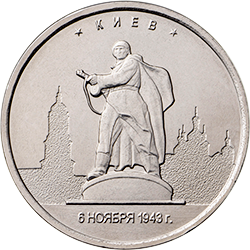The Bank of Russia has issued a series of coins dedicated to the capitals of countries “liberated by Soviet troops from Nazi invaders.”
This is a wonderful opportunity for Russia to use the history of the Second World War to place foreign capitals on its own coins as a reminder that all this was also “ours.”
In this series almost everything is a lie, an attempt to rewrite history again. Let’s start with what today is called liberation. For the many cities included in the bank’s series, it was called something quite different during the war.
I am the grandson of a war veteran and I remember very well what was written on my grandfather’s medals. There was no liberation of Vienna or Budapest. There was capture. The cities were not seen as being occupied by the Nazis, but as capitals or important centers of the Reich and its allies.
But the liberation of Riga, Vilnius, and Tallinn was treated as such. However, these cities — as indeed, Minsk and Kyiv — were not considered the capitals of any countries. They were the capitals of Soviet republics. Again a discrepancy.
Lithuania, Latvia, and Estonia joined the USSR as a result of an agreement between allies — Stalin and Hitler. Therefore, what happened in 1945 was not liberation but the restoration of occupation. And just because Stalin’s allies in the anti-Hitler coalition chose to close their eyes to that fact it did not change the essence of what happened.
Moreover, many allies still continued to consider the Baltic countries as independent states. And in August 1991, the State Council of the USSR recognized the restoration of independence of the Baltic states. The fact of their occupation was officially recognized by the Russian Federation. Therefore, what more is there to say?
There are also major problems when it comes to the cities that had actually been liberated. The Soviet soldier brought not victory but new enslavement to the residents of Belgrade, Bratislava, Bucharest, Warsaw and Prague. Yugoslavia managed to break with the Soviet Union as early as 1948.
Everyone else had to wait several decades for the death of Stalin’s empire. As a result, Soviet troops appeared on the streets of Bratislava, Budapest, and Prague and constantly threatened Poles with intervention. For the residents of the liberated countries that ended up in the Soviet sphere of influence, there were not one but two occupations. Each one horrible in its own way.
 But there is not much difference between the Reich and the USSR, between Stalin and Hitler, between Nazism and Communism. The only difference is that the Reich became dismal history long ago, and the Soviet Union is still agonizing, even though it has been reduced to the size of Putin’s Russia. But it continues to bring death and destruction to neighboring countries.
But there is not much difference between the Reich and the USSR, between Stalin and Hitler, between Nazism and Communism. The only difference is that the Reich became dismal history long ago, and the Soviet Union is still agonizing, even though it has been reduced to the size of Putin’s Russia. But it continues to bring death and destruction to neighboring countries.
In this regard, the issuing of a coin dedicated to Kyiv by the Bank of Russia is one more illustration of the current Russian immorality. After all, after the occupation of Crimea and the Donbas, after thousands of deaths, after attempts to destabilize the situation in our country, do we need to prove that this is a counterfeit coin?





